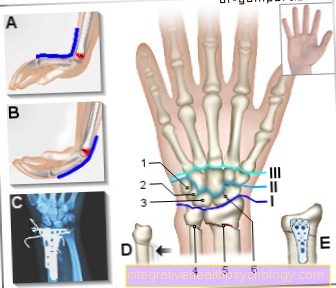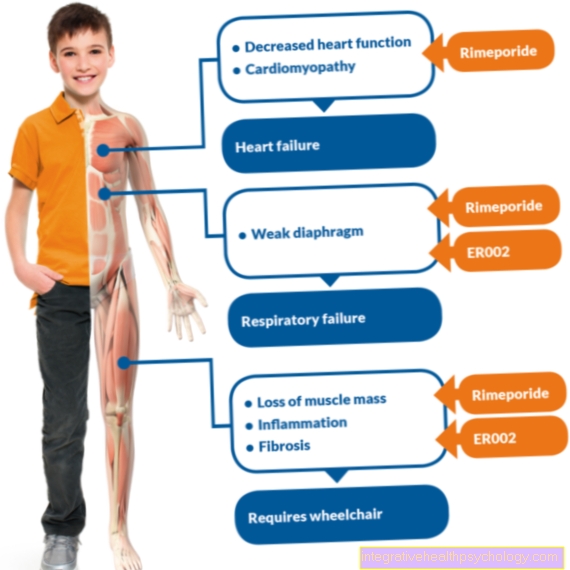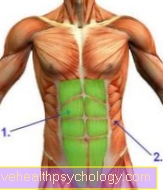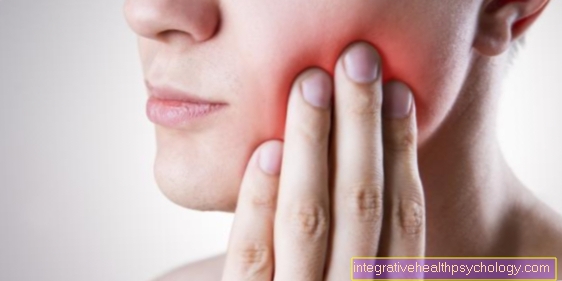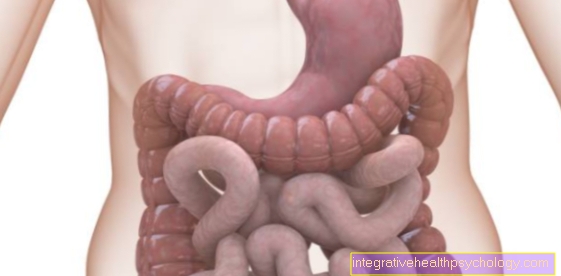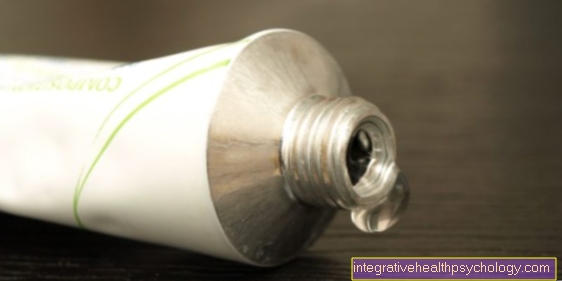denture
Synonyms in the broader sense
Tooth, teeth, upper jaw, jaw, lower jaw, milk dentition,
English: teeth
introduction
The dentition is understood to mean the entirety of the teeth of the upper and lower jaw (Maxilla and Mandible). The development of the teeth begins in the dental ridge before birth. At the age of 6 months, the first teeth appear in the oral cavity (Cavum oris), which is the beginning of the digestive tract. Usually it is the central incisors of the lower jaw. Gradually, the remaining teeth of the upper and lower jaw also break through the gums, and by the age of 2 the tooth eruption is complete.
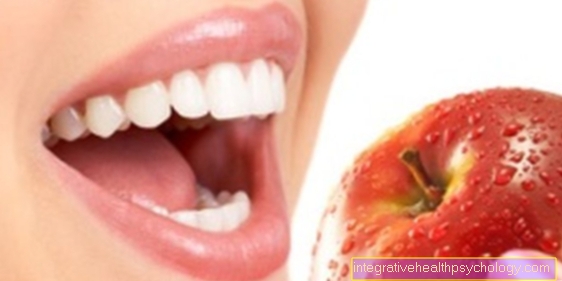
However, there are also harmless deviations in the breakthrough times. So the appearance of the teeth can happen sooner or later.
The pain at the breakthrough is also very different in the children. These teeth make up the 1. Dentition and are called Milk teeth. The Milk teeth (decidual dentition) contains 20 teeth, the small molars are missing (Premolars). The permanent or permanent dentition of the 2nd dentition includes 32 teeth.
Figure dentition
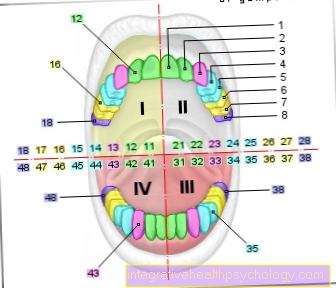
I - right upper jaw -
1st quadrant (11-18)
II - left upper jaw -
2nd quadrant (21-28)
III - lower jaw left -
3rd quadrant (31-38)
IV - lower jaw right -
4th quadrant (41-48)
- 1. Incisor -
Dens incisivus I - 2nd incisor -
Dens incisivus II - Canine tooth -
Dens caninus - 1st molar tooth
Anterior tooth (premolar) -
Dens premoralis I. - 2. Anterior molar
Anterior tooth (premolar) -
Dens premoralis II - 1st molar tooth -
Dens molaris I - 2nd molar tooth -
Dens molaris II - Wisdom tooth (= 3rd molar) -
Dens molaris tertius
(Dens serotinus)
1st - 3rd are front teeth
(3 per quadrant)
4th - 8th are molars
(5 per quadrant)
You can find an overview of all Dr-Gumpert images at: medical illustrations
Milk teeth
The eruption of the milk teeth usually begins with the 2 central incisors (Incisivi) of the lower jaw, followed by the 4 upper incisors, the two lateral lower incisors, the first molars (Molars), the canines (Canini) and finally the second molars. The milk teeth are smaller than the permanent teeth and have a thinner layer of enamel. This makes them more sensitive to acid attacks. A dental check-up of the deciduous teeth is therefore absolutely necessary in order to detect and repair damage in good time. An early loss of milk teeth leads to difficulties in the eruption of the permanent teeth.
However, if it is necessary to remove milk teeth, the inclusion of a gap holder is recommended. Before the permanent teeth appear, the milk teeth move apart as the jawbone grows to make room for the permanent teeth. At the same time, the roots of the milk teeth are reabsorbed, they loosen and fall out. In some cases a milk tooth remains and has to be removed, as otherwise the eruption of the permanent tooth is impaired.
Read more on the topic: Milk teeth
Permanent dentition
The first permanent molar tooth erupts at the age of 6. Since it appears behind the last milk tooth, it is still viewed by many as a milk tooth because no milk tooth falls out.
This molar, also called the 6-year molar because of its appearance, is the first tooth of the 2nd dentition. The change of teeth extends over a period of approximately 8 years. It begins between the ages of 6 and 7. After the first molar erupts, the change begins again with the lower central incisors and ends with the second upper molar. The third molar tooth in the upper and lower jaw plays a special role.
This tooth is known as wisdom teeth, it only appears around the age of 20. In some people it gets stuck in the jaw or it is not attached at all. Failure to invest is a consequence of evolution. Evidence can be provided by an X-ray. X-rays can also be used to determine whether teeth are duplicated or displaced.
Identification of the individual teeth
Various schemes have been introduced for the precise determination of the individual teeth. The most common is the FDI (Federation Dentaire International) formula for teeth. The teeth are divided into 4 quadrants, which are designated by the numbers 1, 2, 3, and 4. It starts with the upper right quadrant, followed by the upper left, lower left and finally the lower right quadrant. The teeth are counted from 1 to 8 from the center. This results in the following picture for the permanent teeth:
top right top left
18 17 16 15 14 13 12 11 21 22 23 24 25 26 27 28
---------------------------- middle --------------------- --------
48 47 46 45 44 43 42 41 31 32 33 34 35 36 37 38
bottom right bottom left
The quadrants of the 20 milk teeth are denoted by the digits 5,6,7 and 8. This results in the following scheme:
55 54 53 52 51 61 62 63 64 65
----------------- middle -----------------
85 84 83 82 81 71 72 73 74 75
Another scheme is the angle system. The corresponding teeth are at angles that indicate the corresponding quadrant, such as? for the upper left quadrant. Baby teeth are designated with Latin numerals such as I, II, III, IV or V, the permanent teeth with Arabic numerals 1 to 8.
Shape and functions of the teeth
The shapes and number of teeth of mammals, to which humans also belong, differ depending on their diet. Such are the teeth of a herbivore (herbivorous) from that of a carnivore (carnivorous) very different. The human teeth are those of an omnivore (omnivorous), as we eat both animal and vegetable foods. The shape of the teeth differs depending on their task.
The incisors and the canines have a wedge-shaped design as they are intended for biting off and tearing food. The small and large molars have a broad surface with cusps and furrows (Fissures). Here the food is chopped up and prepared for the act of swallowing. Every tooth in the upper jaw and also in the lower jaw has two contact teeth (antagonists) on the other row of teeth when the bite is closed.
A healthy, complete set of teeth also shapes the face, it underlines the lip and cheek area. Without teeth, the lips collapse and make people look older. In addition, language loses its expressiveness when teeth are missing. A healthy set of teeth supports the work of the tongue in articulating during pronunciation.
Summary
Human teeth are designed in such a way that they are suitable for both animal and vegetable food. In children between 6 months and 2 years of age, the deciduous dentition forms, the 1st dentition. The milk teeth are replaced by the permanent teeth after they have fallen out, the 2nd dentition. There are schemes for marking the individual teeth, the most common of which is that of the FDI. The teeth have different shapes depending on their task.






